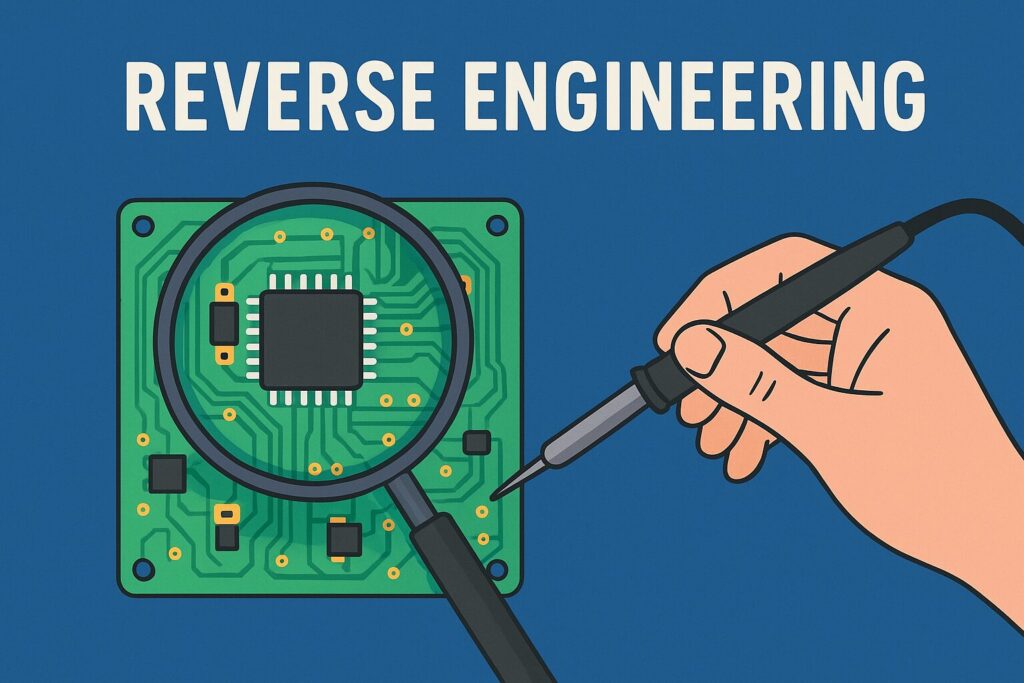Introduction: Rethinking Old Electronics
In today’s fast-paced world of technology, many older electronic devices and machines are no longer supported by their original manufacturers. Spare parts are often unavailable, and original circuit diagrams have long been lost. This is where reverse engineering comes in — a powerful process that allows engineers to analyze, reproduce, and even improve old circuit boards and systems. By doing so, companies can reduce costs, extend the lifespan of their equipment, and integrate modern technology into legacy systems.
There are many reasons why reverse engineering is applied:
- Manufacturer support has ended: Older machines or industrial systems are phased out, and replacement boards are no longer available.
- No circuit diagrams exist: The only working unit is defective, and no replacement can be obtained.
- Need for modernization: The functionality of an outdated system should be recreated more efficiently using modern technology.
- High replacement costs: Reverse engineering allows identical boards to be reproduced at a fraction of the original cost.
In short, reverse engineering extends the life of old electronic systems, enhances sustainability, and reduces production costs.
How Reverse Engineering of Electronic Boards Is Performed
1. Analysis and Inspection of the PCB
The process begins with a thorough physical and visual analysis of the board. Every component, trace, layer, dimension, and connector is carefully examined.
Damaged areas — for instance, those affected by heat or fractures — are identified and repaired using high-resolution scanners or optical microscopes.
2. Component Identification
Each component on the board — including integrated circuits, resistors, capacitors, diodes, and others — is identified individually.
If part numbers are unreadable, the function of the component is determined by tracing its connections.
At the end of this step, a complete Bill of Materials (BOM) is created.
3. Schematic Reconstruction
Once all connections and component values have been determined, a new electronic schematic is drawn using CAD software.
Common tools include Altium Designer, KiCad, and EasyEDA.
This step is essential for understanding the board’s functionality.
4. PCB Redesign
Based on the schematic, a new printed circuit board (PCB) layout is created.
The number of layers, trace widths, hole sizes, and component placement are matched to the original.
Minor improvements — such as better manufacturability or heat dissipation — may also be implemented.
5. Prototype Fabrication and Testing
A prototype of the new board is produced and thoroughly tested.
All signals, power lines, and input/output points are verified.
Once the board functions as expected, production files such as Gerber files, BOM, and assembly drawings are generated for manufacturing.
Tools Used in Reverse Engineering
- Multimeter and oscilloscope
- PCB scanner or microscope
- CAD software for schematics and PCB layout
- X-ray inspection systems (for multilayer boards)
- Programming and analysis tools (for reading microcontrollers)
These tools enable detailed examination of both the hardware and software aspects of a board.
Microcontroller and Software Analysis
Some boards include microcontrollers (MCUs) or EPROMs.
If software is embedded in these chips, reverse engineering also involves firmware extraction and analysis.
The program memory is read out, the firmware is backed up, and — if needed — reprogrammed.
This process must always comply with license and copyright laws, and is done solely to preserve the functionality of the device.
Importance of Reverse Engineering in Industry
Reverse engineering plays a crucial role in industrial automation, defense, energy, medical, and manufacturing sectors.
It allows machines that were built decades ago to remain operational.
Instead of investing in new equipment, repairing and reproducing existing systems is often both cost-effective and environmentally sustainable.
Moreover, reverse engineering isn’t just about replication — it’s about innovation.
An old circuit board can be redesigned to be more efficient, safer, and easier to produce.
Conclusion: Reviving the Past for the Future
Reverse engineering is the art of bringing old electronics back to life.
With the right engineering expertise, even undocumented or obsolete circuit boards can be faithfully reproduced.
Companies benefit from reduced costs while combining the reliability of proven systems with modern technology.
If you’re looking to reproduce or restore your circuit board, an experienced engineering team can help bring your device back to life.
🔗 Get in touch with us :
Phone/WhatsApp: +41 76 212 8248
✉️ E-Mail: info@revantechnology.com
For detailed information about our services in electronics development & PCB design:
Revan Technology – Your partner for professional electronics and PCB development
Discover our recent work:
Revan Technology – Our Projects


